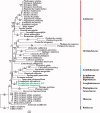The two complete plastomes from Scrophularia (Scrophulariaceae): Scrophularia buergeriana and S. takesimensis
- PMID: 33473602
- PMCID: PMC7800856
- DOI: 10.1080/23802359.2016.1225528
The two complete plastomes from Scrophularia (Scrophulariaceae): Scrophularia buergeriana and S. takesimensis
Abstract
The plastome sequences of Scrophularia buergeriana and S. takesimensis are completed in family Scrophulariaceae. The structure of two Scrophularia plastomes shows similar characteristic with the typical plastome of angiosperm. The lengths of two plastomes are 153,631bp and 152,436bp, respectively. They are divided into LSC region (84,454bp and 83,542bp) and SSC region (17,929bp and 17,938bp) by two IR regions (25,624bp and 25,478bp). Both plastomes contain 113 genes including 79 protein coding genes, 30 tRNA genes and 4 rRNA genes. Eight protein-coding, seven tRNA and four rRNA genes are duplicated in the IR regions. Eighteen genes have one or two intron(s). The overall A-T contents of two genomes are 62.0% and 61.9%, respectively. The A-T content in the non-coding (both 64.5%) is higher than in the coding (60.2% and 60.1%) region. Forty-four and forty-one simple sequence repeat (SSR) loci are identified in the S. buergeriana and S. takesimensis plastomes, respectively. In phylogenetic analysis, the genus Scrophularia shows closed relationship with Plantaginaceae.
Keywords: Scrophularia buergeriana; Scrophularia takesimensis; Scrophulariaceae; plastome.
© 2016 The Author(s). Published by Informa UK Limited, trading as Taylor & Francis Group.
Conflict of interest statement
The authors report no conflicts of interest. The authors alone are responsible for the content and writing of the paper.
Figures

References
-
- Bremer B, Bremer K, Heidari N, Erixon P, Olmstead RG, Anderberg AA, Kallersjo M, Barkhordarian E. 2002. Phylogenetics of asterids based on 3 coding and 3 non-coding chloroplast DNA markers and the utility of non-coding DNA at higher taxonomic levels. Mol Phylogenet Evol. 24:274–301. - PubMed
-
- Carlbom C. 1969. Evolutionary relationships in the genus scrophularia L. Hereditas. 61:287–301.
-
- Choi KS, Park S.. 2016. The complete chloroplast genome sequence of the Korean endemic plant Scrophularia takesimensis. Mitochondrial DNA Part A. 27:2058–2059. - PubMed
-
- Doyle JJ, Doyle JL.. 1990. Isolation of plant DNA from fresh tissue. Focus. 12:13–15.
LinkOut - more resources
Full Text Sources
